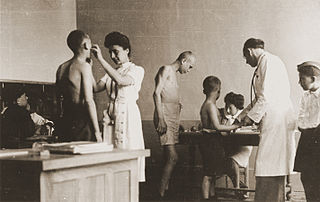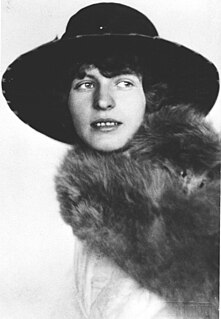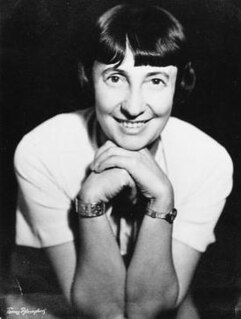 W
WAlfred Brauner was an Austrian-born French scholar, author and sociologist, who was a volunteer in the International Brigades during the Spanish Civil War and an Austrian Resistance member during Occupied France. He has devoted his life to educating refugee, displaced and maladjusted children, participating in the welcoming of Jewish child survivors of the Kristallnacht and of the Nazi concentration camps of Buchenwald and Auschwitz from 1939 to 1946. An early writer on infantile autism, he also pioneered the analysis of children's drawings in war, creating from 1937 the first collection of drawing-testimonials to offer a unique perspective of the major conflicts of the 20th century through the eyes of children.
 W
WFrançoise Brauner, born Fritzi Erna Riesel was an Austrian-born French pediatrician and child psychiatrist who was part of the medical contingent of International Brigades during the Spanish Civil War and was an Austrian Resistance member during Occupied France. She has devoted her medical career to educating refugee, displaced and maladjusted children, participating in the welcoming of Jewish child survivors of the Kristallnacht and of the Nazi concentration camps of Buchenwald and Auschwitz from 1939 to 1946 and working on autism in France since 1956. She also pioneered the analysis of children's drawings in war, creating from 1937 the first collection of drawing-testimonials to offer a unique perspective of the major conflicts of the 20th century through the eyes of children.
 W
WAntonia "Toni" Bruha was an Austrian resistance activist. After the war she became a translator and author.
 W
WFriedrich Cerha is an Austrian composer, conductor and music educator.
 W
WRoman Felleis was an Austrian political activist. He was a close friend of Bruno Kreisky, with whom he founded the "Revolutionäre Sozialistischen" organisation in February 1934. After Austria's annexation by Nazi Germany in March 1938, both men knew it was only a matter of time before the Gestapo would come for them. Kreisky took an opportunity to flee to Sweden later that same year. Felleis refused to leave. He found work as a road builder which enabled him to change his home frequently and live illegally "underground" so that he might, when he considered the time was right, create and develop cells of party activists. He died on 24 August 1944 as the result of an American bombing raid against Buchenwald concentration camp to where, by this time, he had been taken.
 W
WCarmella Flöck was a courier for the Austrian Resistance during the Anschluss of 1938-1945. She was a survivor of the Ravensbrück concentration camp.
 W
WJosef "Sepp" Gangl was a German Major of the Wehrmacht and hero of the Austrian Resistance. He died on 5 May 1945 at Itter Castle, Tyrol. He took part in the defense of Itter Castle against troops of the 17th SS Panzer Grenadier Division "Götz von Berlichingen" with soldiers of the Wehrmacht, the US Army and French prisoners, and lost his life in the process.
 W
WAnna Goldsteiner was a Viennese resistance activist. She was executed.
 W
WMarianne Golz-Goldlust was an Austrian-born opera singer and actress. She maintained a successful career in eastern Europe during the early 1920s, later moving to Prague, Czechoslovakia, and becoming a theatre critic. She married Jewish journalist Hans Goldlust in 1929. When Hans was arrested by Nazis in 1939, Golz-Goldlust secured his release, helping him and his other relatives escape to England. She stayed in Prague to help the Resistance, a dangerous task which she accomplished by hiding Jewish refugees, smuggling financial resources and information across borders, recruiting new resistance members, and holding resistance meetings at her home.
 W
WElfriede Beate Hartmann was a Viennese chemistry student. Towards the end of 1938, some months after the rapid integration of "Austro-fascist" Austria into a newly enlarged German state under the leadership of Adolf Hitler, she became involved with the Young Communists. After war broke out in 1939 she engaged actively in anti-war resistance. On 22 February 1942 she was caught distributing "leaflets" in a park in Vienna-Döbling and arrested. She faced trial at the special "People's Court" at Krems on 22 September 1943 and was found guilty of "preparing to commit High Treason and Helping the Enemy". She died on the guillotine.
 W
WLeo Holzer was an Austrian-Czech firefighter and Holocaust survivor best known for leading the fire brigade inside Theresienstadt concentration camp, which he used as a cover for resistance activities. After the war, he remained in communist Czechoslovakia and became an advocate for Czech-German reconciliation.
 W
WFranz Jägerstätter was an Austrian conscientious objector during World War II. Jägerstätter was sentenced to death and executed for his refusal to fight for Nazi Germany. He was later declared a martyr and beatified by the Catholic Church.
 W
WLeopoldine Kovarik was a post office employee who lived and worked in a suburb on the south side of Vienna. After Austria was merged into Nazi Germany she became a resistance activist. During the Second World War she became a member of a group which used to write letters to members of the army encouraging them to desert. Aged 24, she was convicted under the usual charge of "preparing to commit high treason" and guillotined at Vienna's regional penitentiary, which had incorporated its own execution chamber since the aftermath of the short-lived uprising of 1934.
 W
WGeneralmajor Erwin Heinrich René Lahousen, Edler von Vivremont was a high-ranking Abwehr official during the Second World War, as well as a member of the German Resistance and a key player in attempts to assassinate Adolf Hitler on 13 March 1943 and 20 July 1944.
 W
WHans Maršálek was an Austrian typesetter, political activist, detective, and historian. A devout socialist and active in the resistance, he was arrested by the Nazis and imprisoned in the Mauthausen concentration camp. After the war, he joined the Austrian political police and was instrumental in tracking down and convicting numerous Nazi criminals. He also became the main chronicler of the camp's history, helped establish the Mauthausen Memorial Museum, and published several books.
 W
WKarl Wolfgang Franz Count Motesiczky was an Austrian psychoanalyst and an active opponent of National Socialism. Posthumously, he was honoured as a Righteous Among the Nations.
 W
WRoman Karl Scholz was an Austrian author and Augustinian canon regular at Klosterneuburg. He became a resistance activist after attending a Nuremberg Rally in 1936 and was executed fewer than eight years later.
 W
WMargarete "Grete" Schütte-Lihotzky was an Austrian architect and a communist activist in the Austrian resistance to Nazism. She is mostly remembered today for designing what is known as the Frankfurt kitchen.
 W
WRosa (Hoffman) Stallbaumer was a member of the Austrian Resistance during World War II. Her name is one of 124 names of women and men from Tyrol, Austria inscribed on the Liberation Monument at The Eduard-Wallnöfer-Platz in Innsbruck in recognition of both her involvement in resisting National Socialism and of her death at Auschwitz, following her incarceration at that Nazi concentration camp as punishment for helping Jewish targets of Nazi persecution escape to Italy.
 W
WHanna Sturm was a labour rights and peace activist who became a resistance activist after Austria was merged into Nazi Germany in 1938. She spent the next few years in German concentration camps, but emerged from Ravensbrück camp on 30 April 1945 having survived. Many did not. She wrote an autobiographical record of her experiences in 1958 but was unable to find a publisher: in 1982, two years before she died, the work was published, however.
 W
WAnna Wala was a Viennese fashion model. Later she became a civil servant, working in a government mail censorship office. She also became an anti-government activist. She was arrested, convicted and sentenced. On 24 May 1944 she was executed by guillotine at the Regional Criminal Court in Vienna.
 W
WHilde (Wundsam) Zimmermann, was a member of the Austrian Resistance. Arrested for her efforts to fight fascism, she was deported with her mother and childhood friend by Nazi officials to the Ravensbrück concentration camp in Germany; she then went on to survive both her imprisonment there and a death march.